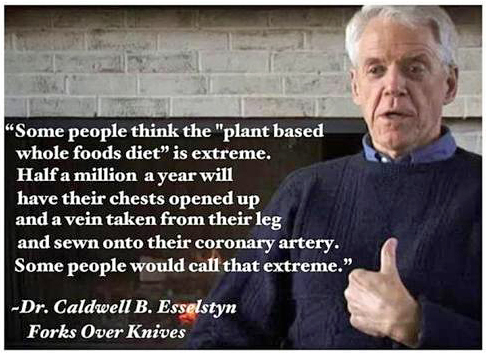Some facts about heart disease from the CDC:
- Heart disease is the leading cause of death for both men and women.
- About 610,000 people die of heart disease in the United States every year. That’s 1 in every 4 deaths.
- Every year about 735,000 Americans have a heart attack.
You don’t have to be overweight to have a heart attack. You don’t have to be a smoker. You don’t have to have high cholesterol. Certainly, being a lean, nonsmoker with low cholesterol helps, but it’s not failsafe. If you’re eating the Standard American Diet (“characterized by higher intakes of red and processed meat, butter, high-fat dairy products, eggs, refined grains”), according to Dr. Esselstyn, you’re putting yourself at risk.
Let me share a story about a young man (44 is young!) from:

Figure 1. “Coronary angiography reveals a diseased distal left anterior descending artery (a). Following 32 months of a plant-based nutritional intervention without cholesterol-lowering medication, the artery regained its normal configuration.”
Resolving the Coronary Artery Disease Epidemic Through Plant-Based Nutrition, Caldwell B. Esselstyn Jr. MD, Preventive Cardiology, June 2007
A recent case is particularly telling. During September and October of 1996, a 44-year-old physician experienced occasional chest discomfort, yet neither electrocardiography, stress echocardiography, nor thallium scanning found evidence of disease. While eating the typical American diet, he had a total cholesterol of 156 mg/dL and an LDL of 97 mg/dL. He was lean, nondiabetic, and normotensive; he did not smoke and had no family history of coronary disease. His lipoprotein(a) and homocysteine levels were normal. On November 18, 1996, after his surgical duties, he became acutely ill with pain in the left arm, jaw, and chest. Immediate coronary catheterization found all vessels to be normal except for the left anterior descending artery, the distal third of which was diseased. Enzyme tests confirmed a myocardial infarction. However, no intervention was deemed appropriate.
This patient was aware of my ongoing study and was curious for more information. He and his wife consulted me for an in-depth review of the plant-based diet and techniques of this coronary disease arrest and reversal study. He became the personification of commitment to the plant-based diet. Over the next 32 months, without cholesterol-lowering drugs, he maintained a mean total cholesterol of 89 mg/dL and an LDL of 38 mg/dL. The repeat angiogram 32 months after his infarction showed that the disease was completely reversed (Figure 1).
Look at that photo. He fixed his artery. He did it without a stent, without drugs, without roto-router. The big deal here is that he fixed not just this one artery, but probably a lot of other arteries in his body that were diseased. If there was a drug that could do this, its creator would be incredibly wealthy.
Dr. Esselstyn, the author of the paper above, wrote a book describing the diet he uses with his patients:
Prevent and Reverse Heart Disease, Dr. Caldwell Esselstyn
Here’s Dr. Esselstyn’s site.
In a nutshell, the diet eliminates all animal food. No meat, fish, chicken, eggs, cheese, yogurt, etc. It also eliminates all added fats and oils. There’s no fast food (no pizza, burgers, fries, donuts, cakes, soda). I know it sounds extreme, but:

Dr. Esselstyn has had enormous success with his diet. In the mid-1980s, he recruited 18 people who had advanced heart disease (heart attacks, angioplasty, bypass). Five were told they had less than a year to live. All but 5 were still alive in 2013. The ones who died did not die of cardiac failure. After beginning the diet, there were no more cardiac events in the 18 people in a 12-year period. Their cholesterol dropped, on average, from 246 mg/dl to 137 mg/dL.
Foods on the diet include grains (rice, oatmeal, corn, whole grain breads and pasta), all fruits, all vegetables, all legumes (beans, peas, lentils). The book includes recipes. His son, Rip Esselstyn, a firefighter, is the author of the popular books, The Engine 2 Diet, and My Beef With Meat both of which promote the work of his father. Good recipes there too.
 I just posted about a study which found that a higher intake of dairy foods increased death from prostate cancer for men who had been diagnosed. Here’s a study by the same group of authors, using the same cohort: 926 men from the Physicians’ Health Study.
I just posted about a study which found that a higher intake of dairy foods increased death from prostate cancer for men who had been diagnosed. Here’s a study by the same group of authors, using the same cohort: 926 men from the Physicians’ Health Study.








